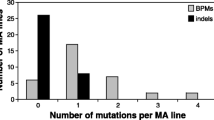Abstract
The sources of spontaneous mutations and molecular details that underlay the production of spontaneous mutations are still poorly understood. One source is related to DNA metabolism involving DNA replication and repair (1,2). Some of the mutator loci indentified in E. coli are related to structural genes for DNA polymerase, and one of them is related to the polA gene, the gene for DNA polymerase I.
Access this chapter
Tax calculation will be finalised at checkout
Purchases are for personal use only
Preview
Unable to display preview. Download preview PDF.
Similar content being viewed by others
References
B.W. Glickman, P.A. Burns, and D.F. Fix, Mechanisms of spontaneous mutagenesis: Clues from altered mutational specificity in DNA repair-defective strains. In: Antimutagenesis and Anticarcinogenesis Mechanisms (D.M. Schankel, P.E. Hartman, T. Kada, and A. Hollaender, Eds.), pp. 259–281. Plenum Press, New York and London, 1986.
R.E. Moses and W.C. Williams, Eds., DNA Replication and Mutagenesis. ASM Press, Washington, D.C., 1989.
A. Kornberg, DNA Replication. W.E. Freeman and Co., San Francisco, 1980.
A. Kornberg, Supplement to DNA replication. W.E. Freeman and Co., San Francisco, 1982.
C.M. Joyce, D.L. 011is, J. Rush, T.A. Steitz, W.H. Konisberg, and N.D.F. Grindley, Relating structure to function for DNA polymerase I of Escherichia coli. In: Protein Structure, Folding and Design, UCLA Symposia on Molecular and Cellular Biology (D. Oxender, Ed.), pp. 197–205. Alan Liss Inc., New York, 1986.
M.B. Coukell and C. Yanofsky, Increased frequency of deletions in DNA polymerase mutants of Escherichia cola. Nature (London) 228:633–636 (1970).
K.K. Vaccaro and E.C. Siegel, Increased spontaneous reversion of certain frameshift mutations in DNA polymerase I deficient strains of Escherichia cola. Mol. Gen. Genet. 141:251–262 (1975).
E.C. Siegel and K.K. Vaccaro, The reversion of trp frameshift mutations in mut, polA, lig, and dnaE mutant strains of Escherichia coli. Mutat. Res. 50:9–17 (1979).
D.J. Savic and S.P. Romac, Powerful mutator activity of the polAl mutation within the histidine region of Escherichia coli K12. J. Bacteriol. 149:955–960 (1982).
G. Streissinger, Y. Okada, J. Emrich, J. Newton, A. Tsugita, E. Terzagi, and M. Inouye, Frameshift mutations and the genetic code. Cold Spring Harbor Symp. Quant. Biol. 31:7–84 (1966).
D.F. Fix, P.A. Burns, and B.W. Glickman, DNA sequence analysis of spontaneous mutation in PolAl strain of Escherichia coli indicates sequence-specific effects. Mol. Gen. Genet. 207:267–272 (1987).
M. Blanco and L. Pomes, Prophage induction in Escherichia coli K12 deficient in DNA polymerase I. Mol. Gen. Genet. 154:287–292 (1977).
C.M. Joyce and N.D.F. Grindley, Method for determining whether a gene of Escherichia coli is essential: Application on the polA gene. J. Bacteriol. 158:636–643 (1984).
R.M. Schaaper, B.N. Danforth, and B.W. Glickman, Mechanisms of spontaneous mutagenesis and analysis of the spectrum of spontaneous mutations in the Escherichia coli lad gene. J. Mol. Biol. 189:273–284 (1986).
G.R. Smith, Chi hot spots of generalized recombination. Cell 34:709–710 (1983).
D. Lockshon and D.R. Morris, Sites of reaction of Escherichia coli DNA gyrase on pBR322 in vivo as revealed by oxolinic acid-induced plasmid linearization. J. Mol. Biol. 181:63–74 (1985).
R.C. Fuller, B.E. Funnell, and A. Kornberg, The dnaA protein complex with the E. coli chromosomal replication origin (oriC) and other DNA sites. Cell 38:889–900 (1984).
P. Hermbomel, B. Bourashot, and M. Yaniv, Two distinct enhancers with different cell specificities co-exist in the regulatory region of polyoma. Cell 39:653–662 (1984).
L.S. Ripley and N.B. Schoemaker, A major role for bacteriophage T4 DNA polymerase in frameshift mutagenesis. Genetics 103: 353–366 (1983).
L.S. Ripley and B.W. Glickman, DNA secondary structure and mutation in cellular responses to DNA damage. In: UCLA Symposia on Molecular and Cellular Biology. A New Series (E.C. Friedberg and B.A. Bridges, Eds.), pp. 521–540. Alan Liss Inc., New York, 1984.
M. Jankovic, T. Kostic, B.W. Glickman, and D.J. Savic, DNA sequence analysis of spontaneous histidine mutations in a PolAl strain of Escherichia coli K12 suggests a sequence-specific effect. Mutat. Res. (submitted).
M.S. Carlomagno, L. Chariotti, P. Alifano, A.G. Nappo, and C.B. Bruni, Structure and function of the Salmonella typhimurium and Escherichia coli K12 histidine operons. J. Mol. Biol. 203:585–606 (1988).
P.E. Hartman, B.N. Ames, J.R. Roth, W.M. Barnes, and D.E. Levin, Target sequences for mutagenesis in Salmonella histidine mutants. Environ. Mutagen. 8:631–641 (1986).
Author information
Authors and Affiliations
Editor information
Editors and Affiliations
Rights and permissions
Copyright information
© 1991 Springer Science+Business Media New York
About this chapter
Cite this chapter
Savic, D.J., Jankovic, M., Kostic, T., Glickman, B.W. (1991). Molecular Basis of Mutagenesis in Escherichia Coli K12 Deficient for DNA Polymerase I: Special Role of the Gtcg Sequence. In: Nygaard, O.F., Upton, A.C. (eds) Anticarcinogenesis and Radiation Protection 2. Springer, Boston, MA. https://doi.org/10.1007/978-1-4615-3850-9_8
Download citation
DOI: https://doi.org/10.1007/978-1-4615-3850-9_8
Publisher Name: Springer, Boston, MA
Print ISBN: 978-1-4613-6718-5
Online ISBN: 978-1-4615-3850-9
eBook Packages: Springer Book Archive




